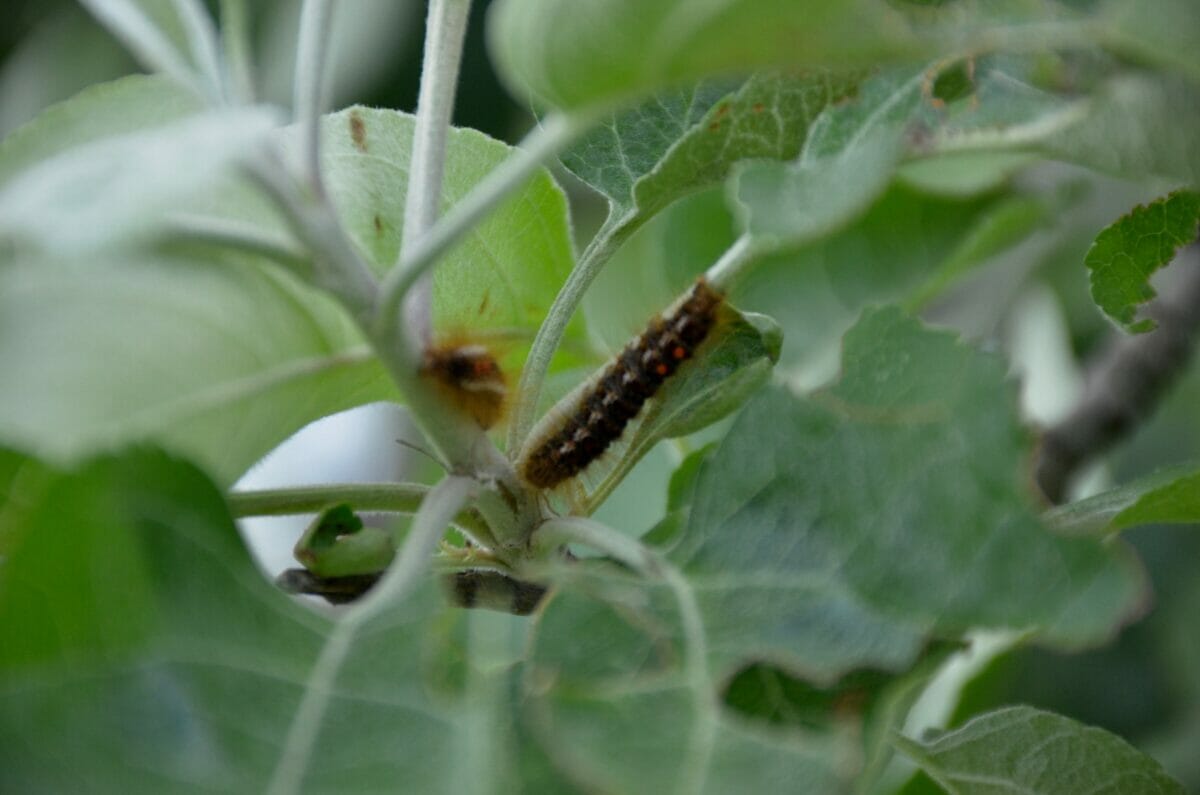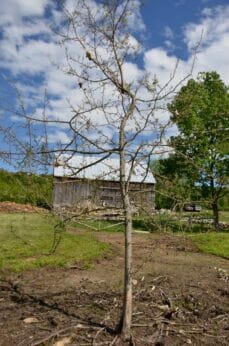Brown Tail Moth Outbreak Makes Life Itchy for Maine Farmers
Warming spring weather spurs outbreak of moths, wreaking havoc on Maine orchards and causing health problems.
Brown Tail Moth Outbreak Makes Life Itchy for Maine Farmers
Warming spring weather spurs outbreak of moths, wreaking havoc on Maine orchards and causing health problems.

Two brown tail moths eat their way through leaves.courtesy of Kirsten Lie-Nielson
As daylight hours lengthen and temperatures begin to warm, you might notice something fluttering in the tops of the still-bare trees around Maine. It’s the silvery, silky nests of the brown tail moth (Euproctis chrysorrhoea) flashing in the sunlight among the budding branches. The caterpillars are brown, with a white stripe down either side of their bodies and two red dots on their backs. In their larval stage, the brown tail moths build nests of webbing and dead leaves in which to overwinter. They emerge tiny and hungry in April, just as the trees begin to leaf out. Capable of decimating entire orchards, the caterpillar continues to eat and grow until June, when they transform into little white moths.
The caterpillars do not just destroy trees. They can do damage to people as well, thanks to the minuscule white hairs that they shed, blowing in the wind or remaining after the caterpillars have departed. The rash can arrive after picking up branches or leaves with moth hairs in them or simply by being outside near an infested tree on a breezy day. The red welts of the rash itch and burn and, unlike poison ivy, the bumps can grow to the size of a dime. The itching and burning can last for more than a week. In some cases, the hairs of the caterpillars can cause respiratory distress, and if you have pre-existing respiratory issues, these can be extremely serious. For farm workers, foresters and anyone laboring outside in Maine, this is one of the hazards of the job.
Brown tail moths first arrived in the US in the late 19th century by way of Cape Cod. For nearly twenty years, the population exploded across New England, Quebec and the Tri-State area. However, the introduction of a parasitoid fungus and aggressive applications of obsolete sprays such as arsenate of lead brought the population under control by the 1920s. Minor outbreaks would occur throughout the 20th century. The parasitoid fungus, entomopohaga aulica, thrived in the cool, wet New England weather, keeping the moth population under control until 2015, when an outbreak began along the Maine coast. This outbreak has stayed largely within the state, which has entomologist Tom Schmeelk, of the Maine Forest Service perplexed. “There hasn’t been a clear definitive answer for why it has not expanded back to its reach in the early 1900s.”
However, it is suspected that Maine’s increasingly warm and dry spring weather has played a role. The fungus that proved so effective at controlling the moths naturally in years past requires a cool, wet spring to thrive. The moth larvae thrive on warmer and drier conditions, and Maine has suffered moderate to severe droughts since 2015. With no natural agents to combat them, the brown tail moths have thrived.
When Sarah Pike purchased Tops’l Farm in Waldoboro, ME, in 2015, she had a vision of a glamping getaway and farm destination. What she didn’t know was that many of the beautiful apple trees lining the property’s walk to the Medomak River had already succumbed to brown tail moth infestation. “Losing many of the ancient apple trees on the farm within the first few months of our stewardship to the brown tail moth, felt like the property lost a really important part of its story.”
Pike began to combat the moths. She attempted spraying the apple trees and tall oaks that surrounded her farm, but the moths kept returning. Eventually, Pike began a regimen of daily nest clipping and caterpillar squishing. The most effective way to combat the moths is by clipping their nests out in late fall or early spring, when the caterpillars are dormant and the nests are most noticeable. Barrier bands around tree trunks can also prevent caterpillars from attacking a tree, as long as any existing nests are thoroughly removed.

While brown tail moths are generalists, they do seem to prefer fruit trees and oak trees, putting a strain on Maine orchards. Bob Sewall is the steward of Sewall Organic Orchard, the oldest organic orchard in the state. Sewall has been tending his orchard for more than forty years. Brown tail moth caterpillars first began to appear in his trees four years ago, and he quickly found them to be more destructive and persistent than any pest he had faced before. Having never sprayed his trees, his first focus was to prune the larval clusters out.
“We took over 1,200 nests out,” Sewall says. “And we still didn’t get them all. It was a losing battle; if you miss one nest, that can defoliate an entire tree.”
Fortunately for Sewall and Pike, sprays are available that are effective against the moths. Sewall uses a combination of BT and Entrust organic insecticide, and he now sprays his orchard twice a year with this mix. But spraying is ineffective in a 65-foot-tall oak tree, and the moth population across the state continues to grow.
While some urban towns have organized volunteer efforts to clip out the moth nests on town property, the battle against brown tail moths has been left largely in the hands of individual landowners. In a state covered in majestic, old-growth trees that reach up to the sky, clipping and spraying both require a tree crane, which has greatly hampered individuals’ efforts to fight the outbreak. The Maine Forest Service suggests that if hiring a crane is cost prohibitive, a collection of neighbors might combine resources to have their area treated, but such co-operation does not always occur.
While Maine scientists hope for a natural decrease in the moth’s population, they are also working on other mitigation methods, such as the release of the female sex pheromone, which confuses the males and disrupts the mating cycle. “This would be highly specific to the brown tail moth, so no non-target effects on beneficial insects,” says University of Maine Forest Entomologist Angela Mech. “It is eco-friendly and has the potential to be highly effective for a large area.”
While we wait for new mitigation methods or a return of the moth killing fungus, Mainers will continue to suffer from the brown tail moth rash. Long sleeves and limiting outdoor time can help reduce the risks of the rash developing, but for farmers who have to be outside every day and often work directly in moth-infested areas, topical ointments and sprays are available that specifically treat the brown tail moth rash and can provide relief.
“We are still in an outbreak,” Mech says. “We will be itchy this summer.”
Follow us

This work is licensed under a Creative Commons Attribution-NoDerivatives 4.0 International License.
Want to republish a Modern Farmer story?
We are happy for Modern Farmer stories to be shared, and encourage you to republish our articles for your audience. When doing so, we ask that you follow these guidelines:
Please credit us and our writers
For the author byline, please use “Author Name, Modern Farmer.” At the top of our stories, if on the web, please include this text and link: “This story was originally published by Modern Farmer.”
Please make sure to include a link back to either our home page or the article URL.
At the bottom of the story, please include the following text:
“Modern Farmer is a nonprofit initiative dedicated to raising awareness and catalyzing action at the intersection of food, agriculture, and society. Read more at <link>Modern Farmer</link>.”
Use our widget
We’d like to be able to track our stories, so we ask that if you republish our content, you do so using our widget (located on the left hand side of the article). The HTML code has a built-in tracker that tells us the data and domain where the story was published, as well as view counts.
Check the image requirements
It’s your responsibility to confirm you're licensed to republish images in our articles. Some images, such as those from commercial providers, don't allow their images to be republished without permission or payment. Copyright terms are generally listed in the image caption and attribution. You are welcome to omit our images or substitute with your own. Charts and interactive graphics follow the same rules.
Don’t change too much. Or, ask us first.
Articles must be republished in their entirety. It’s okay to change references to time (“today” to “yesterday”) or location (“Iowa City, IA” to “here”). But please keep everything else the same.
If you feel strongly that a more material edit needs to be made, get in touch with us at [email protected]. We’re happy to discuss it with the original author, but we must have prior approval for changes before publication.
Special cases
Extracts. You may run the first few lines or paragraphs of the article and then say: “Read the full article at Modern Farmer” with a link back to the original article.
Quotes. You may quote authors provided you include a link back to the article URL.
Translations. These require writer approval. To inquire about translation of a Modern Farmer article, contact us at [email protected]
Signed consent / copyright release forms. These are not required, provided you are following these guidelines.
Print. Articles can be republished in print under these same rules, with the exception that you do not need to include the links.
Tag us
When sharing the story on social media, please tag us using the following: - Twitter (@ModFarm) - Facebook (@ModernFarmerMedia) - Instagram (@modfarm)
Use our content respectfully
Modern Farmer is a nonprofit and as such we share our content for free and in good faith in order to reach new audiences. Respectfully,
No selling ads against our stories. It’s okay to put our stories on pages with ads.
Don’t republish our material wholesale, or automatically; you need to select stories to be republished individually.
You have no rights to sell, license, syndicate, or otherwise represent yourself as the authorized owner of our material to any third parties. This means that you cannot actively publish or submit our work for syndication to third party platforms or apps like Apple News or Google News. We understand that publishers cannot fully control when certain third parties automatically summarize or crawl content from publishers’ own sites.
Keep in touch
We want to hear from you if you love Modern Farmer content, have a collaboration idea, or anything else to share. As a nonprofit outlet, we work in service of our community and are always open to comments, feedback, and ideas. Contact us at [email protected].by Kirsten Lie-Nielsen, Modern Farmer
April 4, 2023
Modern Farmer Weekly
Solutions Hub
Innovations, ideas and inspiration. Actionable solutions for a resilient food system.
ExploreExplore other topics
Share With Us
We want to hear from Modern Farmer readers who have thoughtful commentary, actionable solutions, or helpful ideas to share.
SubmitNecessary cookies are absolutely essential for the website to function properly. This category only includes cookies that ensures basic functionalities and security features of the website. These cookies do not store any personal information.
Any cookies that may not be particularly necessary for the website to function and are used specifically to collect user personal data via analytics, ads, other embedded contents are termed as non-necessary cookies.